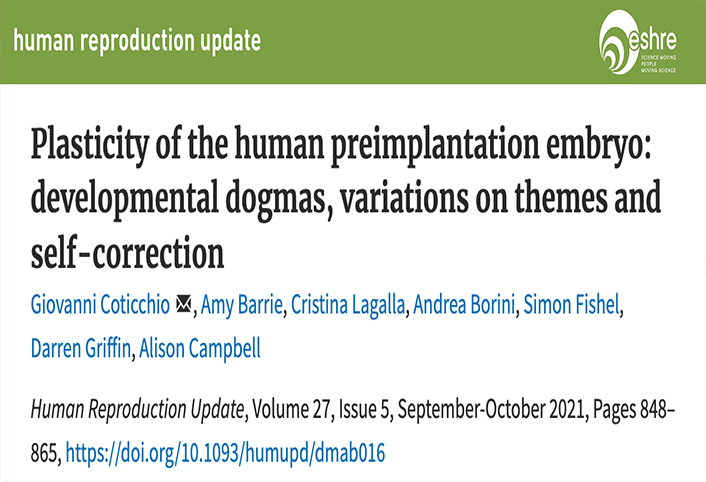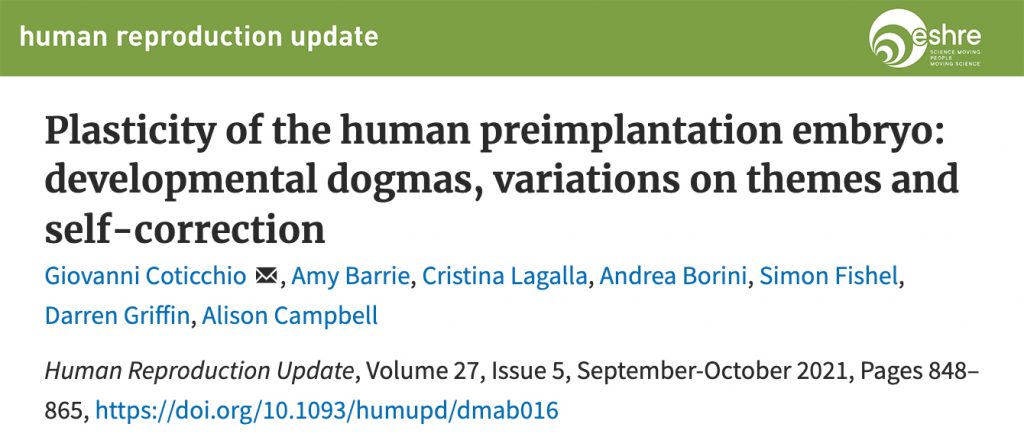
Giovanni Coticchio, Amy Barrie, Cristina Lagalla, Andrea Borini, Simon Fishel, Darren Griffin, Alison Campbell
Human Reproduction Update, Volume 27, Issue 5, September-October 2021, Pages 848–865, https://doi.org/10.1093/humupd/dmab016 Published: 15 June 2021
Abstract
BACKGROUND: IVF for the treatment of infertility offers unique opportunities to observe human preimplantation development. Progress in time-lapse technology (TLT) and preimplantation genetic testing (PGT) has greatly expanded our knowledge of developmental patterns leading to a healthy pregnancy or developmental failure. These technologies have also revealed unsuspected plastic properties of the preimplantation embryo, at macromolecular, cellular and multicellular levels.
OBJECTIVE AND RATIONALE: This review focuses on the emerging concept of plasticity of the human embryo as revealed by recent evidence derived from TLT and PGT, calling for an updated and more precise redefinition of the boundaries between normal and abnormal development.
SEARCH METHODS: PubMed was used to search the MEDLINE database for peer-reviewed English-language original articles and reviews concerning human preimplantation development. Cross-searches were performed by adopting ‘fertilisation‘, ‘pronucleus’, ‘cleavage’, ‘multinucleation’, ‘compaction’, ‘embryo’, ‘preimplantation genetic testing’, ‘aneuploidy’, mosaicism’, ‘micromanipulation’, ‘time-lapse microscopy’ and ‘IVF/assisted reproduction’ as main terms. The most relevant publications, i.e. those concerning major phenomena occurring during normal and abnormal development—with a focus on the human species—were assessed and discussed critically.
OUTCOMES: Advances in TLT and PGT have revealed an astonishing plasticity and self-correction ability of the human preimplantation embryo in vitro. At fertilisation, an abnormal number of pronuclei do not always result in the formation of an aneuploid blastocyst. Animal studies and preliminary human observations indicate that combining of parental genomes may occur at the early cleavage stage, if not at fertilisation. Multinucleation occurs with much higher prevalence than previously thought and may be corrected at later cleavage stages. Irregular cleavage (multichotomous, direct, rapid and reverse cleavages) can generate chromosome segregation abnormalities that often lead to developmental arrest, but that sporadically may be confined to cells excluded from the blastocyst, and may sometimes result in viable pregnancy. Mitotic errors can generate mosaic blastocysts, but alternatively normal embryos may form from selective death or clonal depletion of aneuploid cells.
WIDER IMPLICATIONS: Deviations from developmental dogmas and the increasing evidence of plasticity of the human embryo challenge current embryological notions and suggest the need to write new rules governing cell cycle, cell determination and chromosome segregation during preimplantation development.

